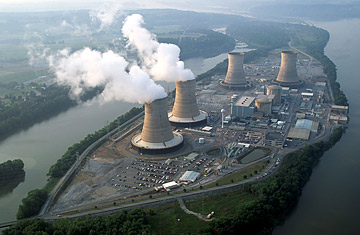
Three Mile Island Nuclear Power Plant
(9 of 11)
In Middletown (pop. 11,000), the streets were unusually empty. Some teenage boys played basketball outside an elementary school. Many residents were following instructions to remain inside their houses and to keep air conditioners turned off to limit the intake of any contaminated air. To prevent looting, Mayor Robert Reid imposed a 9 p.m.-to-7 a.m. curfew. The Red Cross was ready for any full-scale evacuation. It was no new thing, in a way; the town had been cleared during several recent floods, dating from the big one of 1972. Across the river, tiny Goldsboro (pop. 600) was virtually a ghost town.
Some residents had an I-told-you-so attitude toward the accident. They had opposed the building of the plant from its start. They failed to prevent Unit 1 from being placed in operation in 1974. When construction of Unit 2 began in 1970, the opponents renewed their fight, but to no avail. Some 100 people from the Goldsboro area rallied in protest on May 31, 1977, and released balloons into the air that carried tags advising any finder: FALLOUT FROM A NUCLEAR ACCIDENT MAY TRAVEL THIS FAR. Chauncey R. Kepford, a leader of the local protesters, warned more than a year ago before the NRC appeal panel: "Unit 2 is an accident just waiting to happen. And when it does, the glib assurances that the public health and safety are being protected will not suffice."
Afer preliminary tests were conductid on Unit 2 last year, Harrisburg area opponents went to court to try to prevent it from being put into full operation. They lost again, and Unit 2 was placed on line last Dec. 30. It had been operating at full capacity for only about five weeks when the accident happened.
Sensing that the nuclear power industry had been badly wounded by the events at Three Mile Island, antinuclear groups moved into action across the country. Near Minneapolis and Eau Claire, Wis., they demonstrated against nuclear power plants, crying, "It could happen here!"
Once again, Folk Singer Joan Baez lent her plaintive voice to a rally in San Francisco, where her colleagues staged a "die-in," falling under the onslaught of an imagined nuclear disaster. Plants from Oregon to New York and Connecticut came under fire from the antinuclear brigade. Said a TVA official about last week's accident: "This will be just another piece of ammunition that the protesters can use. But frankly, it has a lot more substance than most of the things they've had."
